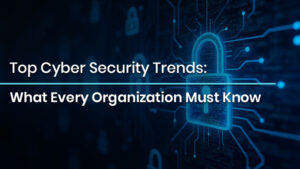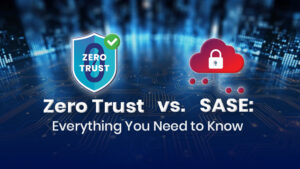
Top Cyber Security Trends: What Every Organization Must Know
Top Cyber Security Trends: What Every Organization Must Know Introduction In an era marked by digital transformation, remote workforces, and rapidly evolving threat landscapes,
Limited-Time Offer! Get an exclusive 40% OFF on IPSpecialist Premium Monthly & Annual Plans. Use Promo Code: UPSKILLNOW at checkout.

Top Cyber Security Trends: What Every Organization Must Know Introduction In an era marked by digital transformation, remote workforces, and rapidly evolving threat landscapes,

Zero Trust vs. SASE: Everything You Need to Know Introduction As the cyber world continues to change, companies need to look beyond conventional security

Cloud Security Posture Management (CSPM) Introduction In the era of digital transformation, organizations are moving to the cloud at an unprecedented pace. While the
Table of Contents
In the digital-first economy of today, cloud transformation is no longer a choice but a necessity. Organizations are finding themselves in a rapidly evolving technology environment fueled by calls for agility, innovation, cost management, and data ownership. Two of the most debated cloud models with flexibility and durability are Hybrid Cloud and Multi-Cloud.
Ready to take the next step in your cloud journey? Whether you’re leaning toward a hybrid model, a multi-cloud strategy, or a combination of both, IPSpecialist Services has the expertise to guide you every step of the way. Our certified professionals deliver tailored cloud solutions that align with your goals, ensuring security, scalability, and success.
Whether you’re beginning your cloud journey or expanding enterprise infrastructure, IPSpecialist Services’s Cloud Transformation Services provide solid, secure, and cost-saving solutions that align with your business objectives. From architecture design to hybrid deployments, our certified professionals assist you in transforming with confidence. Learn how our services can drive your next cloud initiative.
A Hybrid Cloud integrates on-premises infrastructure (private cloud) with one or more public cloud platforms, enabling data and applications to move between them seamlessly. Workload portability is supported and sensitive data and legacy systems have improved control.
For instance, you could keep mission-critical finance systems on-premises but place customer-facing applications in the public cloud. This yields the advantages of both worlds—control and scalability.
Multi-Cloud is when two or more public cloud providers (e.g., AWS, Azure, Google Cloud) are utilized for distinct services or workloads. The aim is to prevent vendor lock-in, enhance reliability, and maximize performance or cost based on the provider’s strengths.
An e-commerce business, for example, might utilize AWS for its AI models, Azure for data analytics, and GCP for storage—leveraging each provider’s strengths.
1. Deployment and Architecture
Hybrid Cloud infrastructures are closely integrated, bridging on-premise installations with public clouds via secure, orchestrated platforms. They need to have a consistent infrastructure approach for unproblematic data flow and app support.
Multi-Cloud deployments are less integrated. Independent clouds are used from each cloud vendor, each having individual environments typically supporting unique applications or business units.
2. Vendor Independence and Flexibility
Hybrid Cloud is still partly dependent on proprietary equipment or a certain provider. That may restrict ability to change vendors or move to newer platforms.
Multi-Cloud enables companies to diversify by providers, and they are not reliant on one vendor, improving negotiating leverage.
Hybrid Cloud models provide higher control of sensitive information through retention in-house or within a private cloud. Such a deployment is best for healthcare, financial services, or governmental sectors subject to stringent compliance regulations (HIPAA, GDPR).
Multi-Cloud providers similarly provide strong security, but same policy enforcement between several environments proves tricky. Security applications must be separately integrated into each platform.
4. Cost Optimization
Hybrid Cloud facilitates savings in capital expenditure (CapEx) by using existing infrastructure with peak workloads offloaded to the public cloud. Yet, running a private cloud can be expensive.
Multi-Cloud permits companies to pick services on a competitive pricing basis and performance. But having to deal with several providers can mean hidden costs and billing complexity.
5. Redundancy and Resilience
Hybrid Cloud configurations depend on limited cloud-provider choices. When the on-prem or public environment goes down, disaster recovery might be difficult without extra failover systems.
Multi-Cloud naturally facilitates failover, disaster recovery, and high availability by spreading workloads across providers, so it’s more resistant to downtime.
6. Scalability and Innovation
Hybrid Cloud offers scalability through the public cloud, but scaling resources can be constrained by the on-premises component’s capacity.
Multi-Cloud offers infinite scalability and exposure to leading-edge innovations like AI, ML, serverless computing, and quantum cloud services—on multiple platforms.
7. Complexity and Management
Hybrid Cloud environments are complicated but simpler to govern under a common governance model. Centralized software can monitor security, workloads, and performance.
Multi-Cloud introduces complexity around having to deal with multiple tools, APIs, SLAs, and dashboards. Governance, visibility, and orchestration become difficult without a strong cloud management platform (CMP).
Whether you implement any of these cloud models, IPSpecialist Services offers support in hybrid and multi-cloud. What we offer:
Hybrid vs Multi-Cloud is not a question of which is better, but which is appropriate to your company. A Hybrid Cloud model fits into compliance-intensive environments and legacy setups. However, a Multi-Cloud strategy provides unparalleled flexibility, resilience, and innovation capabilities.
Ultimately, the best solution may actually be a mix of both, guided by your own unique business objectives, compliance requirements, and tech strategy. Through working with an established cloud leader like IPSpecialist Services, you can facilitate a smooth migration with industry-best practice alignment and scalable architecture for the future.
1. Is it possible for a company to follow both hybrid and multi-cloud strategies?
Yes. Most businesses employ hybrid-multi cloud infrastructures—integrating on-prem environments with several public clouds—to establish ultimate flexibility, security, and redundancy.
2. Is the multi-cloud environment more secure than hybrid cloud?
Not necessarily. Multi-cloud takes more work to consolidate security policies between platforms. Hybrid cloud provides more control but might not offer the redundancy advantages of multi-cloud.
3. What is the greatest challenge in multi-cloud adoption?
Management and governance complexity. Companies are required to manage numerous SLAs, dashboards, and security frameworks unless they implement centralized multi-cloud management solutions.
© 2025 All rights reserved | Privacy Policy | Terms and Conditions | Sitemap | Cookie Policy




